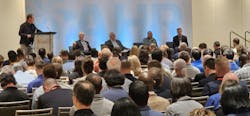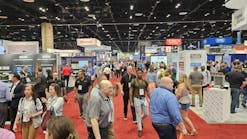The U.S. Green Building Council (USGBC) and UL recently announced a strategic partnership focused on increasing disclosure, awareness, and transparency of building-product composition and manufacturing processes.
The partnership will produce several targeted initiatives. The first is the creation of joint environmental product declarations (EPDs). An EPD is a standardized way of quantifying the environmental impact of a product or system.
“Life-cycle impacts and human health are two of the key underpinnings of LEED,” Rick Fedrizzi, president, chief executive officer, and founding chair of the USGBC, said. “We believe in buildings and products that limit environmental impact from conception to completion and that optimize the health of our families, colleagues, and customers. UL is the world’s leading safety consulting and certification group, and our partnership will advance that mission enormously.”
Sara Greenstein, president of UL's Environment—Information & Insights business unit, said the partnership grew out of buyers’ demand to know the full extent of products' environmental and health impacts.
“Transparency into the impacts of a product at each stage of its life cycle has become a critical driver of purchases and specifications,” Greenstein said. “Since this market is still evolving, and because the quality and consistency of data can vary greatly, we are working diligently to ensure that buyers and LEED users can trust that the information on which they rely is accurate and that it complies with the new credit requirements. This partnership between USGBC and UL will help businesses, individuals, and project teams better understand the products they are including in their building projects and have greater clarity about how those products can contribute to LEED credits.”
Scot Horst, senior vice president of global innovation and LEED, USGBC, said the USGBC will continue to forge strategic alliances such as this.
“We know that increased consumer education and market knowledge will drive consumer choices to more responsible and sustainable products,” Horst said. “This is the first time USGBC is tying the built environment to products that will receive LEED credit, which is a huge step toward preventing green-wash.”
Horst continued: “This partnership will accelerate LEED in the marketplace and help maintain its leadership standard through technical rigor and stringency. Equally important, it will incentivize those product manufacturers out there who are doing amazing things with their products and establishing themselves as leaders within their industry. We want to create a system to reward them.”








